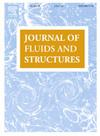Numerical analysis of vortex-induced vibration of deep-sea mining riser with auxiliary pipes based on discrete vortex method
IF 3.5
2区 工程技术
Q1 ENGINEERING, MECHANICAL
引用次数: 0
Abstract
Air injection and discharge pipes play an essential role in the deep-sea mining airlift process, and their influence on the flow field and riser vortex-induced vibration (VIV) is not fully investigated. In this study, the discrete vortex method is modified to incorporate the influence of multiple solid domains, and the flow field evolution in the presence of auxiliary pipes is simulated. Based on the assumption that the vortex structure is constant within a certain spanwise length, an analytical model is established by strip theory and a weakly coupled fluid-structure interaction approach to investigate riser VIV in the cross-flow direction. The results show that the auxiliary pipes will interfere with the vortex shedding of the main riser and inhibit the formation of a stable wake pattern, which leads to a reduction in both the amplitude and frequency of the lift force. The VIV exhibits a mixed behavior of standing and travelling waves, and multi-mode responses induced by temporal drift of the frequency can be observed. In addition, the auxiliary pipes suppress the VIV by disturbing vortex shedding and increasing the bending stiffness of the riser. Moreover, the effects of inflow angle, current velocity, and vessel navigational motion on the VIV response and power region distribution are investigated. Specifically, a 45° inflow angle provides optimal VIV suppression and leads to the narrowest power-in region, while vessel motion in either the upstream or downstream direction aggravates VIV and significantly alters the power region distribution.
基于离散涡法的深海矿用辅助管立管涡激振动数值分析
注排气管在深海采矿气举过程中起着至关重要的作用,但其对流场和隔水管涡激振动的影响尚未得到充分的研究。本文对离散涡旋法进行了改进,纳入了多个固体域的影响,并模拟了辅助管道存在时的流场演化。基于涡结构在一定展长范围内不变的假设,采用条形理论和弱耦合流固耦合方法建立了横流方向上立管涡动的解析模型。结果表明,辅助管道会干扰主隔水管的涡流脱落,抑制稳定尾迹的形成,导致升力的幅值和频率降低。该系统表现出驻波和行波的混合特性,并且可以观察到频率随时间漂移引起的多模态响应。此外,辅助管通过干扰旋涡脱落和增加立管的弯曲刚度来抑制涡激振动。此外,还研究了入流角、流速和船舶航行运动对涡激振动响应和功率区域分布的影响。具体来说,45°入流角提供了最佳的涡激振动抑制,并导致最窄的动力区域,而船舶在上游或下游方向的运动加剧了涡激振动,并显著改变了动力区域的分布。
本文章由计算机程序翻译,如有差异,请以英文原文为准。
求助全文
约1分钟内获得全文
求助全文
来源期刊

Journal of Fluids and Structures
工程技术-工程:机械
CiteScore
6.90
自引率
8.30%
发文量
173
审稿时长
65 days
期刊介绍:
The Journal of Fluids and Structures serves as a focal point and a forum for the exchange of ideas, for the many kinds of specialists and practitioners concerned with fluid–structure interactions and the dynamics of systems related thereto, in any field. One of its aims is to foster the cross–fertilization of ideas, methods and techniques in the various disciplines involved.
The journal publishes papers that present original and significant contributions on all aspects of the mechanical interactions between fluids and solids, regardless of scale.
 求助内容:
求助内容: 应助结果提醒方式:
应助结果提醒方式:


